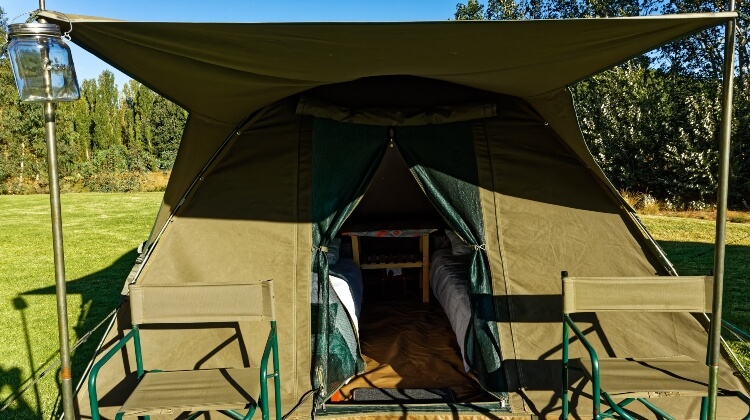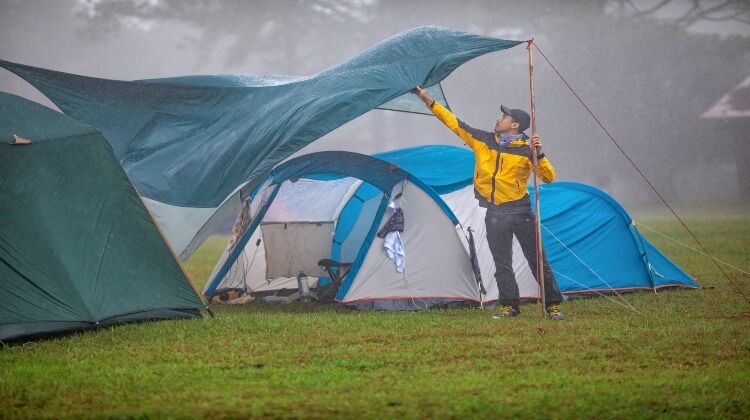
The key to a successful trip is a high-quality and reliable tent. Therefore, before buying a tent, you should determine what rainfly material it is made of and whether it can withstand difficult weather conditions.
The most popular natural material used to make tents is tarpaulin. It is a dense, wind-resistant, yet breathable fabric.
The second popular natural material is Teflon-coated cotton. It is moisture-resistant and does not wrinkle.
However, these two are not the only solutions. In the next section, we will discuss ten materials of the flysheet and how to care for them.
What Is The Best Rainfly Material?
For the manufacture of tents, they used different types of materials. Each of them is intended for use in certain conditions. Let’s consider what materials are most often used in producing rain fly and tent products.
Tarpaulin

Tarpaulin is a dense, wear-resistant material made from natural fibers, including cotton, linen, jute, and cotton. Thanks to special impregnations, it is not afraid of rain, wind, snow, and fire.
It is one of the most durable textile materials in various industries. Tarpaulin is superior in quality to PVC materials.
It stands out by wear resistance and durability, temperature stability, elasticity, opacity, resistance to deformation. Besides, the low cost of this fabric allows you to use it in almost any quantity.
However, the disadvantages of tarpaulin are often critical. Its heavy products are heavy, do not tolerate low temperatures, and are quickly wet.
Teflon Coated Cotton
Natural fiber textiles are popular in industries where people require a large volume of inexpensive covering material. So, Teflon-coated cotton is widely used in making tent-fly.
However, this fabric does not protect well from moisture, despite the coating, and when wet, becomes too heavy.
Oxford
Oxford fabric is made from nylon or polyester, weaving the threads matting. This texture ensures the high durability of the products.
Oxford can withstand the toughest weather conditions. It stands out by improved properties: high strength, lack of hygroscopicity, moisture resistance, waterproof, durability.
But its cost is higher than nylon varieties.
Taffeta

Taffeta is available in nylon or polyester coated with polyurethane. Sometimes it comes with a white or silver dusting.
Nylon taffeta reliably protects from precipitation, but it makes a kind of greenhouse in the tents due to the inability to let air through.
Polyester is better breathable, but its strength is lower.
Raincoat Fabric
The raincoat fabric made from polyester and cotton is reliable, durable, and strong. Even when wet, the raincoat fabric does not tear or deform.
Greta
This material is a type of twill-weaving polyester. Its advantages are ease of use, increased density, and water resistance.
The Greta tent-flap is easy to clean and wash. It does not fade in the sun and does not shrink after washing.
Monaco
Monaco is specially designed for the production of tent-fly. This fabric has a high level of protection against rain and wind.
In the presence of polyurethane impregnation, it becomes completely waterproof. Monaco is well-painted, has inscriptions, logos, and drawings, making the tent-fly of different colors.
Gala
Gala is a rubberized waterproof material designed for use in the warm season. Amateur travelers choose it for its ease of use, durability, and low cost.
But, in winter, it can crack and then tear from the frost.
Ripstop
This fabric has a combined weaving structure with reinforced yarns. It features strength, deformation resistance, water resistance, fire resistance, UV resistance.
Rip-stop is not subject to decay and the development of microorganisms.
PVC Materials

It is a two- or three-layer fabric made of synthetic fibers of nylon, Lavan, or nylon with a PVC coating. It stands out in strength, durability, resistance to moisture, and aggressive substances.
PVC material does not fade in the sun and does not deform over time. The presence of an insulating layer makes PVC capable of withstanding negative temperatures.
Comparison Table
| Material | Advantages | Disadvantages |
| Tarpaulin | Durable, strength, wear resistance, moisture resistance, durability, opacity, low cost. | Heavyweight |
| Teflon-coated cotton | Eco-friendly, breathable, inexpensive | No protection from rain, gets wet quickly and dries for a long time. |
| Oxford | Durable, heat-retaining, weather-resistant | No |
| Taffeta | Waterproof, dries quickly, crease-resistant | Insufficiently strong, poorly holding temperature, afraid of an open fire, airtight |
| Raincoat fabric | Durable, lightweight, dries quickly, wear-resistant, inexpensive | Quickly get wet without a protective layer |
| Greta | Durable, lightweight, waterproof, colorfast, wrinkle-free | Poor air permeability |
| Monaco | Strong, dense, windproof, moisture resistant, easy to paint | Heavy |
| Gala | Waterproof, durable, lightweight, inexpensive | It does not tolerate low temperatures |
| Rip-stop | Durable, moisture-resistant, heat-retaining, crease-resistant, relatively lightweight | High price |
| PVC materials | Durable, wear-resistant, resistant to aggressive substances, water-repellent | It does not allow air to pass through. |
What Does The Difference In Materials Used In A Rainfly Mean?

The two main ingredients that makeup all the flysheet fabrics are nylon and polyester. Of course, there are many differences between them.
Polyester has a strong waterproof feature and resists deformation when the temperature changes. Because it possesses a sturdy construction, it is quite heavy to move.
In contrast, nylon is very light, making it extremely convenient to store and carry. However, its disadvantage is that it is absorbent and deforms when wet.
A hybrid product has appeared to combine the advantages and eliminate the disadvantages of the two materials above. This combination features the water-resistance of polyester and the lightweight nature of nylon.
In addition, a new invention that can replace polyester and nylon is silicone material with PU coating. This product lasts longer and is more mildew resistant.
Characteristics Of A Good Rainfly
Choosing a good fabric for your tent is not easy, as there are many nuances to consider. Experts say that special materials for rain fly must meet several requirements.
Water Resistance
Choosing a waterproof tent material is better to protect you from rain, snow, and fog. The height of the water column will determine the water resistance.
| Water-resistance index | Meaning |
| Below 2000 mm | Such fabric will be water-repellent, not waterproof. So its use for making a tent is highly undesirable. |
| 2000-3000 mm | This level of water resistance is suitable for tents used on simple hikes during the warmer months. |
| 3000-5000 mm | Optimal water resistance for general camping and camping tents |
| 5000 mm and above | Materials with this level of waterproofing are ideal for use in extreme weather conditions. |
If the tent fly can have an indicator from 2000 to 5000 mm, then the bottom of the tent must be especially waterproof and have an indicator of at least 5000 mm.

But remember that the better the water resistance, the heavier the tent. It’s because the weight depends on the thickness of the protective layer.
The density Of Weaving Of Threads
Another important indicator that characterizes the tent fabric is the density of the threads weaving. The higher the value, the denser and heavier the fabric:
| The density of weaving of threads | Fabric characteristics |
| 150-180 T | Suitable for interior walls |
| 200-250 T | Suitable for camping tent |
| 350-420 T | Suitable for floors |
| 420 T and above | Suitable for tents used in extreme conditions |
Also, there may be marks D, Pu, and Si in the marking.
The letter D stands for the thickness of the threads. The higher this figure, the stronger the tent will be.
The Pu mark indicates the presence of polyurethane impregnation, which indicates good water resistance.
If the specification has a Si mark, the material will have a silicone coating, which improves the tent’s quality, strength, and water resistance.
Fire Retardant Impregnation
A significant disadvantage of most tent fabrics is the risk of fire in the event of a fire. Fire retardant impregnation allows you to endow textile materials with refractory properties.
A tent fly made of such fabric will protect a person from the effects of fire. It also reduces the flame propagation speed in the event of a fire.
The manufacturer used homogeneous inhibitors based on fluorine, iodine, and heterogeneous alkali metal salts for rain-fly fabrics. They inhibit chemical reactions when heated, thus reducing or stopping the possibility of tissue inflammation.
Weight
The weight should be light. It is especially important for hiking and cycling trips. It will help if you choose a compact foldable tent to put in a backpack or bag.
How To Take Care Of A Rain Fly?
Take Care Of A Rain Fly
Rainfly requires careful and regular maintenance. For the most part, synthetic fabrics are capricious in their care, so the care of products made from them should be special.

To keep your tent performing well for a long time, there are a few tips to keep in mind to maintain all types of material:
- Set the “Handwash” mode if you use machine wash.
- In no case should the water temperature rise above 40 degrees?
- It is recommended to use mild detergents, including laundry and baby soaps.
- Rub the flysheet carefully.
- Dry your tent fabrics out of direct sunlight.
- Ironing is not necessary.
It would help if you also remembered to store the tent in a dry place where rodents will not climb. Before storing it, you must wash and dry it.
A careful attitude guarantees its long service life while preserving all existing characteristics.
Rainfly Alternatives

It is a pity you cannot use your rainfly because it is dirty or torn. In this case, you can consider some alternatives.
We recommend using a lightweight tarp as a tent cover. However, you need to consider the features of the tarp to determine if it is suitable to be a rain fly.
First, it must be waterproof. A tarp made of canvas coated with waterproof wax is a reasonable alternative.
The second choice is poly tarps. They are waterproof and UV resistant. However, they are quite heavy.
A weatherproof PVC tarp is also useful. It is water-resistant, tear-resistant, and UV resistant.
In the end, Iron Horse Polyester Tarps is the best choice to replace a rainfly. It is not only waterproof but also breathable. Most importantly, it is more durable than canvas.
Watch this video to get tips, tricks, hacks for rain fly:
Conclusion
The rainfly materials mentioned above differ in their operational properties and composition. But most of them feature high density, strength, water resistance, and crease resistance.
You should choose materials that are light and easy to clean. In all cases, try to clean the flysheet by hand.If you want to machine wash it, follow the instructions in the article “Can you machine wash a rain fly?” Thank you for reading!
Leave a Reply